Witness the profound symbolism of brides in the Bible, revealing mysteries of relationships and divine connections that beckon deeper exploration.
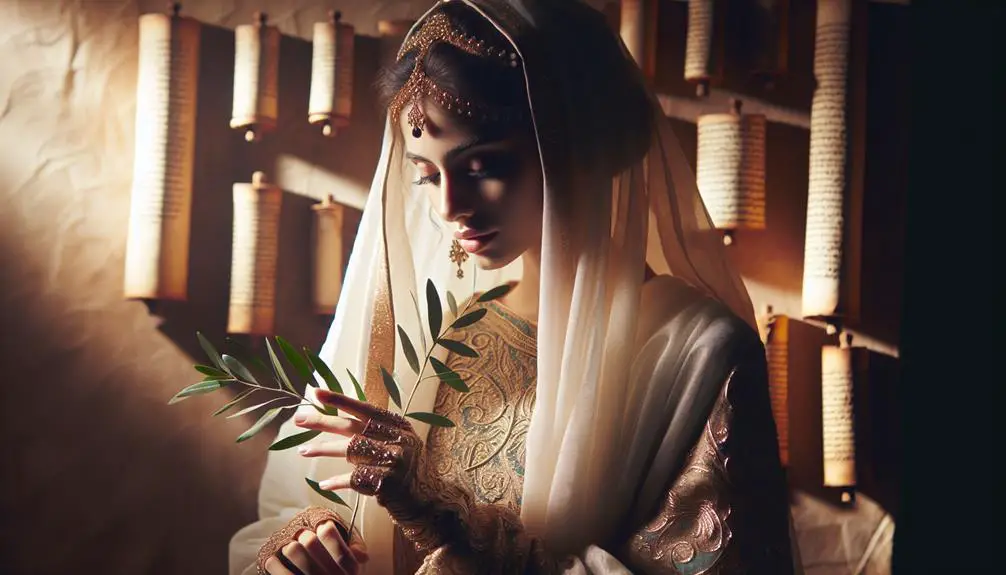
Bride in the Bible
You've likely heard tales of weddings that were so grand they could bankrupt a small country, but even those pale in comparison to the rich tapestry of bridal narratives woven throughout the Bible.
These stories aren't just about vows and veils; they're imbibed with profound symbolism, reflecting everything from historical marriage customs to the mystical union described as the Bride of Christ.
As we explore these narratives together, you'll discover layers of meaning that might just change how you view relationships, commitments, and spiritual connections. Curiosity piqued? Good, because we're only scratching the surface.
Key Takeaways
- Bridal imagery in the Bible symbolizes covenant relationships and spiritual purity.
- Ancient marriage customs, including dowries and feasts, reflect socio-economic and spiritual significance.
- The Bride of Christ metaphor represents the Church's intimate relationship and destiny with Christ.
- Marital symbolism throughout scripture emphasizes covenantal love and the eschatological hope of renewal.
Historical Context of Biblical Marriages
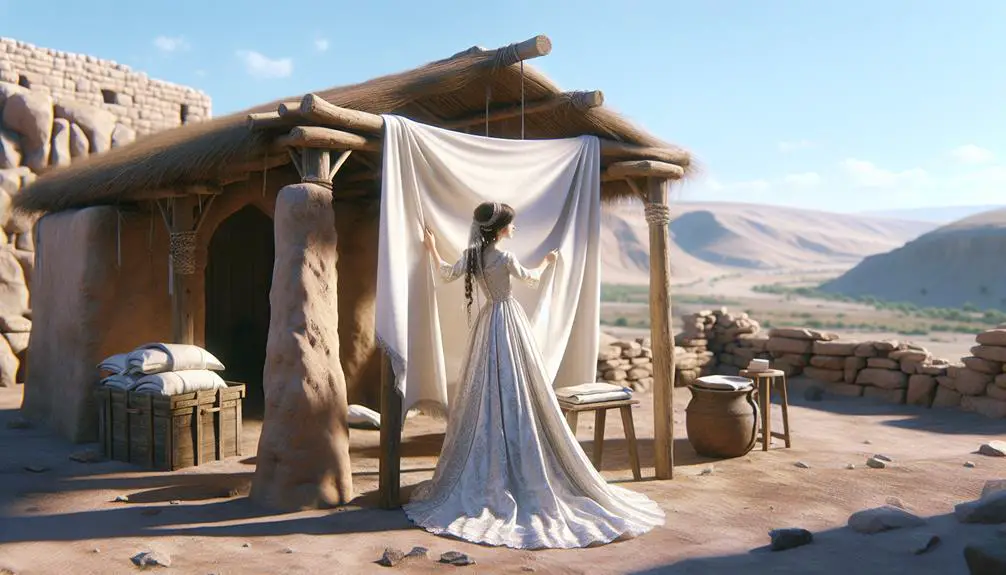
In understanding the historical context of biblical marriages, it's crucial to recognize that these unions often served not only personal but also socio-political purposes, frequently reflecting the broader dynamics of ancient Near Eastern societies. Dowry practices and polygamy norms were integral components of these marital arrangements, each playing a significant role in shaping societal structures and individual relationships.
You'll find that dowry practices weren't merely about parents providing for their daughters; they were strategic moves within a socio-economic framework. These practices ensured alliances between families, secured social status, and sometimes acted as a form of protection for the bride. The dowry could include land, money, or goods, and its size often reflected the family's social standing. This system underscored the transactional nature of biblical marriages, where women's value was closely tied to their dowries.
Polygamy norms further complicate the picture. While not universally practiced, polygamy was accepted among certain segments of ancient Near Eastern societies, including those depicted in the Bible. This marital structure was often adopted by the wealthy or those of high social status, as multiple wives could signify wealth and power. However, polygamy also had practical considerations, such as ensuring numerous offspring, which were vital for labor and the continuation of familial lines.
Understanding these practices sheds light on the complex interplay between marriage, economics, and power in biblical times. It's essential to grasp that these weren't just personal choices but were deeply embedded in the socio-political fabric of the era.
Symbolism of the Bride in Scripture
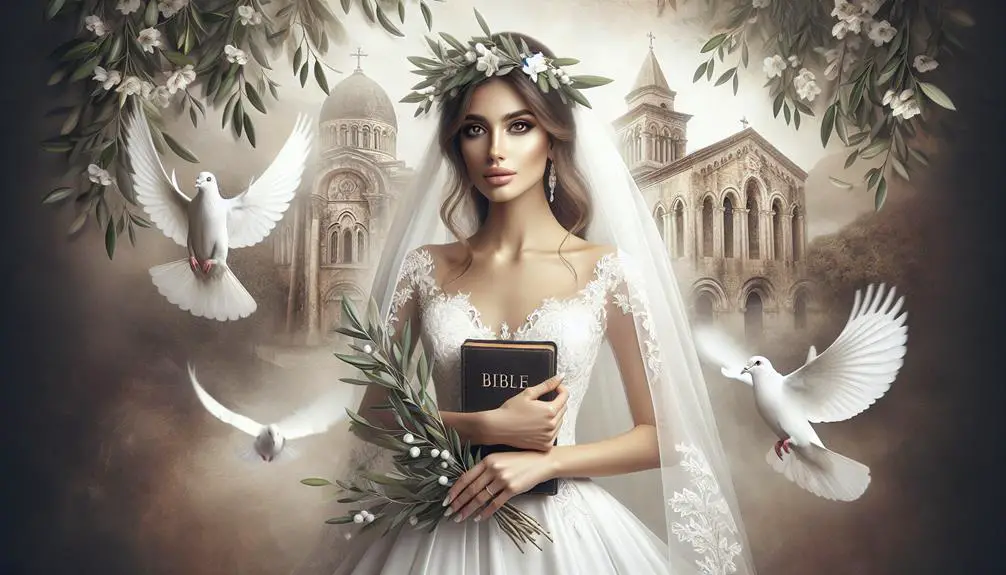
Throughout scripture, the bride often symbolizes a covenant relationship, reflecting the profound spiritual and communal bonds established through biblical narratives. This imagery isn't just about the physical union of two people but delves deeper into the spiritual and moral commitments that such a union represents. Bridal purity, in this context, isn't solely about chastity but symbolizes a broader spiritual purity and readiness to enter into a sacred covenant with God. This purity isn't a static state but a dynamic process of preparation, signifying the individual's or community's ongoing effort to align with divine will.
Wedding feasts in scripture further enrich this symbolism, serving as a metaphor for the joyous culmination of a spiritual journey and the beginning of a new covenantal relationship. These feasts aren't merely celebrations of a matrimonial union but are deeply imbued with theological significance, representing the eschatological hope of a renewed creation where God's presence is fully realized among His people. The lavishness and inclusivity of these biblical feasts underscore the abundant grace and mercy that characterize the divine-human relationship, inviting all to partake in the communal rejoicing that accompanies the fulfillment of divine promises.
In essence, the bride in scripture embodies a multi-layered symbol of purity, preparation, and joyous celebration, pointing beyond itself to the deeper spiritual realities of covenant, redemption, and divine fellowship. This symbolism invites you to ponder the rich tapestry of meanings behind the biblical portrayal of brides and wedding feasts, encouraging a deeper engagement with the spiritual dimensions of these narratives.
The Bride of Christ Explained
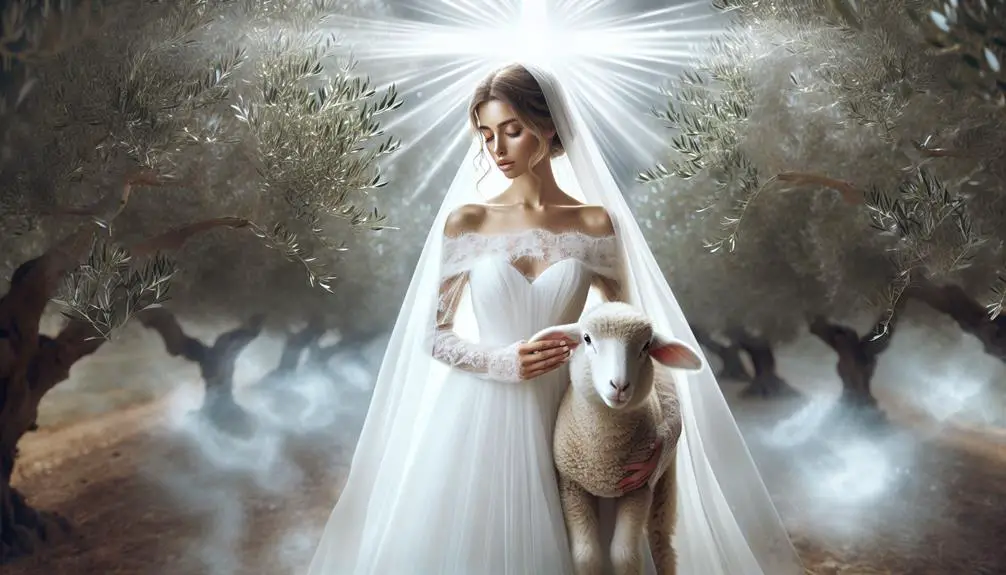
Delving into the concept of the Bride of Christ reveals a profound theological metaphor that encapsulates the relationship between Christ and His Church, characterized by love, commitment, and collective redemption. This imagery isn't merely decorative but unpacks layers of meaning about the Church's identity and its ultimate union with Christ. To comprehend this, you must dive deep into its scriptural foundations and historical interpretations.
The metaphor of the Bride and Christ as the Bridegroom finds its roots in the New Testament, notably in Ephesians 5, where Paul discusses the relationship between husbands and wives as mirroring that of Christ and the Church. This analogy extends beyond mere comparison, imbuing the Church with a sacred identity as the beloved of Christ, destined for an eternal, covenantal union.
Understanding this relationship offers:
- Insight into the Church's identity: The Church isn't an institution but a community called to live in loving relationship with Christ, reflecting His love to the world.
- A perspective on collective redemption: The metaphor underscores a communal aspect of salvation, where believers are collectively prepared as a bride for the coming of Christ.
- Anticipation of the Eschatological celebration: It points towards the ultimate celebration, the marriage supper of the Lamb, where the faithful will be united with Christ in fullness.
This rich metaphorical language serves as a cornerstone for Christian theology, offering a multifaceted understanding of the Church's role and destiny. It elevates the Church's mission, emphasizing its call to purity, love, and readiness for the eschatological celebration that awaits.
Marriage Customs in Ancient Times
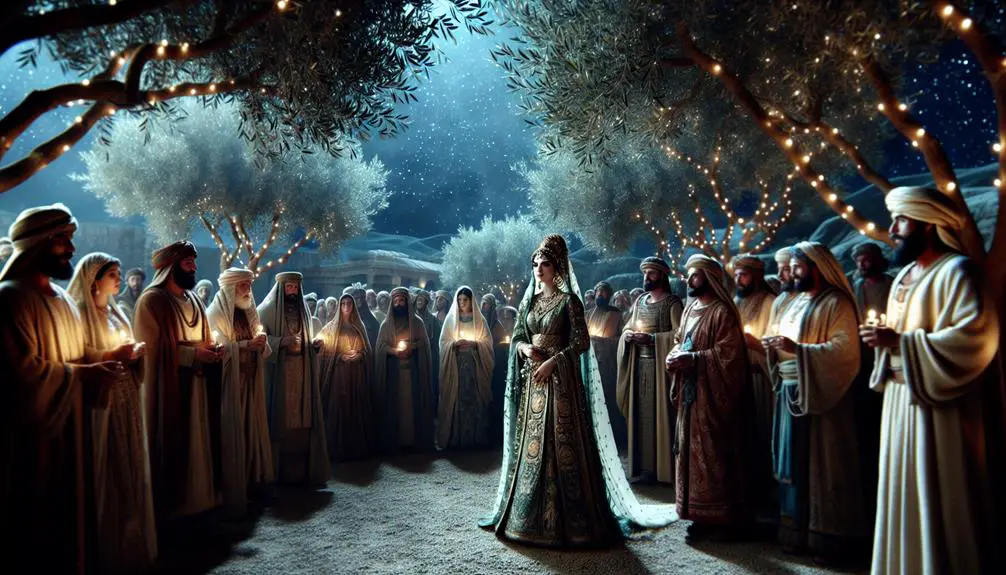
To understand the metaphor of the Bride of Christ fully, it's essential to explore the marriage customs prevalent during ancient times, which significantly influenced this biblical imagery. In these societies, marriage wasn't just a union between two individuals but a complex process involving legal, social, and economic considerations.
Dowry practices played a pivotal role in ancient matrimonial arrangements. You'd find that a dowry, often consisting of money, property, or other valuable assets, was provided by the bride's family to the groom or his family. This practice wasn't merely transactional but served various purposes, including helping to establish the new household and serving as a form of protection for the bride in case of widowhood or divorce. It's crucial to recognize how these practices underscored the value placed on marriage as a strategic alliance between families, rather than merely an affair of the heart.
Wedding feasts, on the other hand, were grand celebrations that highlighted the communal aspect of marriages. These weren't just simple gatherings but elaborate festivities that could last several days, symbolizing not only the joy of the union but also the families' social status. The feast served as a public declaration of the newly formed bond, witnessed by the community, and sanctioned by cultural and religious norms.
Understanding these customs sheds light on the depth of the Bride of Christ metaphor, illustrating the commitment, preparation, and celebration inherent in the concept of spiritual union and covenant in biblical texts.
Notable Brides in the Bible
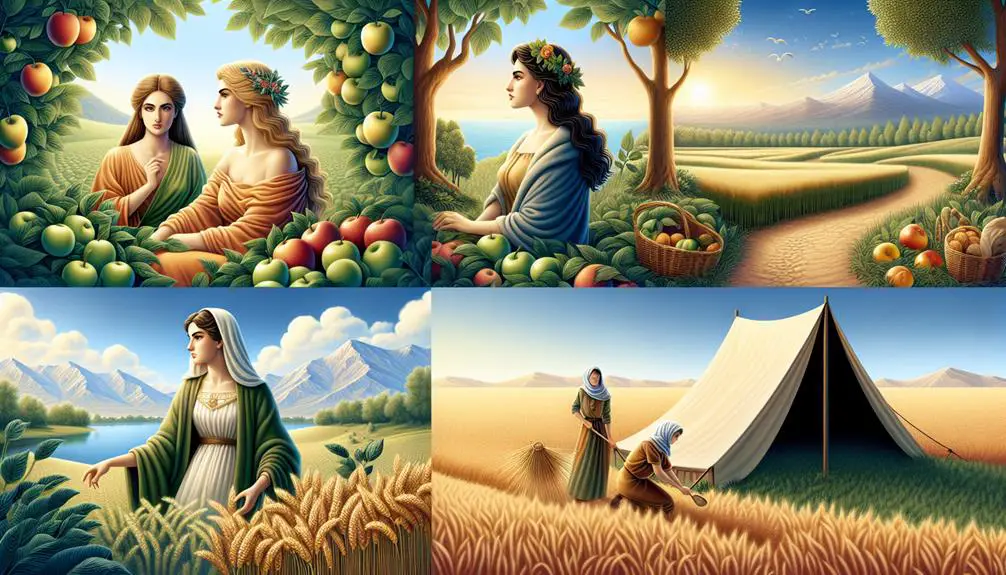
Having explored the intricate marriage customs of ancient times, we now turn our attention to the notable brides in the Bible, whose stories exemplify these traditions and deepen our understanding of the symbolic Bride of Christ. These women's experiences shed light on the cultural and spiritual significance of marriage in biblical times, emphasizing the roles of wedding attire and dowry practices.
- Rebekah: Chosen for Isaac, Rebekah's story highlights the dowry practices of the time. Her family received gifts, a practice that not only secured alliances but also signified the groom's commitment. Rebekah's journey to become Isaac's wife, adorned for her new role, illustrates the transformative power of wedding attire as a symbol of entering into a covenant relationship.
- Rachel and Leah: In the narrative of Jacob, Rachel and Leah's stories underscore the complexity of marital arrangements and the significance of dowry. Jacob's labor for their father, Laban, acts as a form of dowry, reflecting the societal norms where marriage agreements often included substantial commitments and negotiations.
- Esther: Though not a traditional bride in the context of dowry practices, Esther's preparation to meet King Ahasuerus—with extensive beauty treatments and specific attire—emphasizes the importance of wedding attire in her transformation and elevation to queen. Her story exemplifies how attire and preparation for marriage can symbolize purification and readiness for a new role.
Through these narratives, you gain insight into the depth of marriage traditions in the Bible, revealing how wedding attire and dowry practices weren't merely cultural norms but carried deeper meanings, contributing to our understanding of covenant relationships and divine unions.
Spiritual Union and Commitment
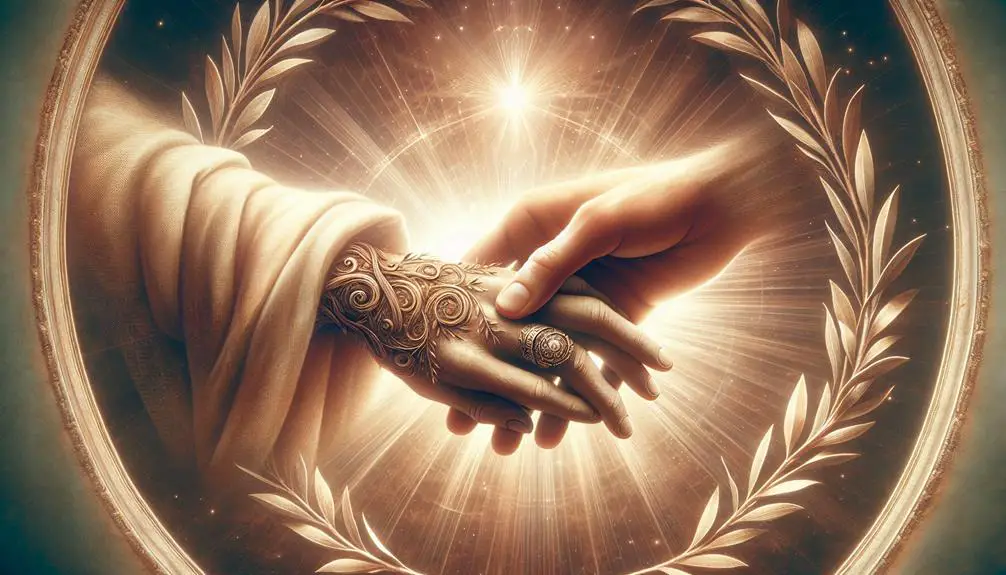
As you explore the symbolism of marriage within biblical narratives, you'll find that it serves as a profound metaphor for covenantal love between the divine and humanity. This union isn't merely a legal agreement but is imbued with spiritual significance, reflecting a deep, committed relationship.
Such an analysis underscores the intricate layers of meaning behind marital imagery, revealing the complex interplay between love, commitment, and spiritual fidelity in biblical texts.
Symbolism of Marriage
In the context of biblical teachings, marriage symbolizes a profound spiritual union and commitment, mirroring the covenant between God and His people. This covenant isn't merely a contract but a deeply relational bond, expressed through various love languages and celebrated with wedding feasts, symbolizing joy and divine approval.
- Wedding feasts represent communal joy and divine blessing, reinforcing the idea that marriage is both a personal and communal covenant.
- Love languages in biblical marriages highlight the importance of understanding, serving, and committing to one another in diverse ways, reflecting God's multifaceted love for His people.
- The spiritual union underscores the indissoluble bond, suggesting that marriage isn't only a physical union but a profound spiritual intertwining of lives, akin to Christ's union with the Church.
Analyzing these elements, you'll grasp the depth of marriage symbolism in biblical contexts, beyond mere human conventions.
Covenantal Love Explored
Delving into covenantal love reveals its essence as not just a commitment, but a spiritual union that mirrors the profound relationship between God and His people. This union transcends modern relationships, integrating love languages into a sacred covenant. You'll find that each expression of love, whether through words of affirmation or acts of service, echoes the divine commitment God extends to humanity.
Biblical Covenant |
Modern Relationships |
|---|---|
Unconditional love |
Conditional affections |
Eternal commitment |
Temporal connections |
Spiritual union |
Physical attraction |
Acts of service |
Love languages |
Divine guidance |
Personal desires |
Analyzing this table, you recognize covenantal love's depth, a blueprint for relationships that seek to emulate the unwavering, sacrificial love showcased in biblical narratives.
Bridal Imagery in Prophecy
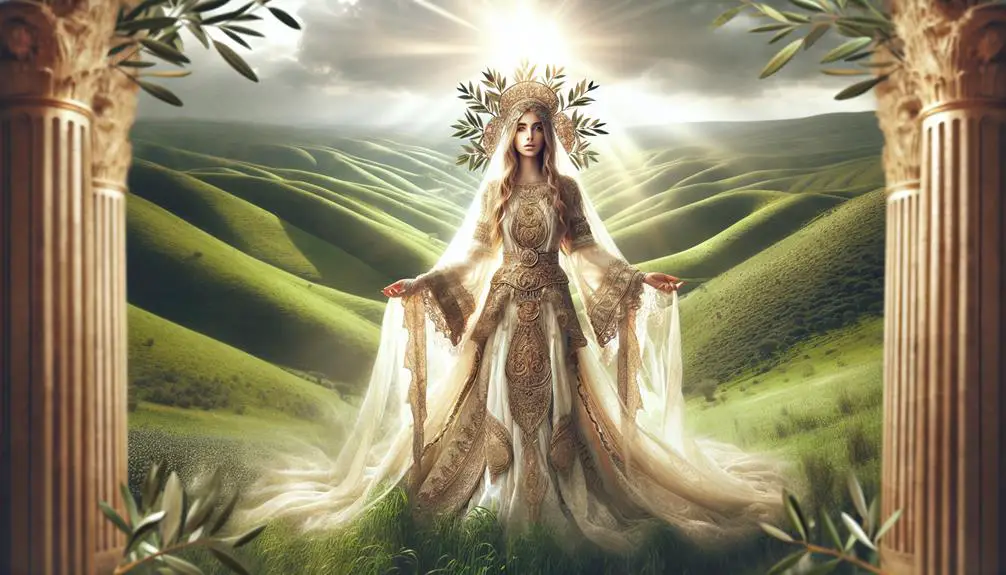
You'll find that biblical prophecy is rich with bridal imagery, symbolizing deep spiritual truths.
The marriage metaphor in Revelation, for instance, illustrates the union between Christ and His church, while Israel's betrothal imagery throughout the Old Testament highlights her covenant relationship with God.
Moreover, the foretold return of the Bridegroom underscores the anticipated culmination of this divine love story.
Marriage Metaphor in Revelation
Exploring the Book of Revelation reveals a profound use of bridal imagery to symbolize the union between Christ and the Church, underscoring the spiritual covenant that transcends earthly marriage. The apocalyptic visions culminate in the depiction of a heavenly banquet, where the Church is presented as a bride adorned for her husband, Christ.
- Apocalyptic Visions: Serve as a backdrop for unveiling the ultimate union, highlighting the contrast between earthly struggles and heavenly triumph.
- Heavenly Banquet: Symbolizes the eternal celebration of this holy union, emphasizing the joyous culmination of divine promises.
- Spiritual Covenant: Reflects the depth of commitment between Christ and the Church, going beyond physical bonds to a profound spiritual connection.
This metaphorical language not only enriches our understanding of divine love but also invites reflection on the eternal significance of this celestial marriage.
Israel's Betrothal Imagery
Biblical prophecy frequently employs Israel's betrothal imagery to illustrate the nation's covenant relationship with God, revealing a profound spiritual engagement that foreshadows the ultimate reconciliation and union. This engagement process isn't merely symbolic but deeply embedded in the cultural and theological fabric of ancient Israel.
The dowry significance, in this context, transcends mere economic transaction. It represents God's commitment, provision, and promises to Israel, underscoring a divine investment in the relationship's future. This imagery, rich in cultural nuance, serves not only to depict God's unwavering loyalty to His people but also to highlight Israel's called response of faithfulness and purity in anticipation of the promised union.
Analyzing this imagery offers insights into understanding the depth of the covenantal bond between God and Israel.
Bridegroom's Return Foretold
As the narrative unfolds, prophetic texts foretell the return of the bridegroom, an event deeply steeped in bridal imagery, symbolizing the anticipated culmination of God's covenant with His people. This motif, rich in apocalyptic imagery, serves as a critical lens through which the faithful are invited to interpret their own place within the divine narrative.
- Apocalyptic imagery underscores the transformative power of this eschatological event, marking a pivotal shift in cosmic order.
- Parable interpretations offer nuanced insights into the nature of readiness and faithfulness required of the expectant community.
- Covenant fulfillment emphasizes the profound relational bond between the divine and humanity, restored and consummated in the bridegroom's return.
This layered symbolism invites you to delve deeper into the complexities of faith, hope, and divine promise.
Frequently Asked Questions
How Do Modern Interpretations of Biblical Brides Influence Contemporary Wedding Practices and Ceremonies?
You'll find that modern interpretations of biblical brides shape today's wedding customs significantly. Cultural influences and dress symbolism, deeply rooted in historical texts, impact how ceremonies are performed and what brides wear.
Analyzing these connections reveals a rich tapestry of tradition and innovation. As traditions evolve, they borrow elements from these ancient narratives, blending them with contemporary values and aesthetics, leading to a dynamic interplay between the past and present in wedding practices.
Are There Any Documented Cases of Brides Who Challenged or Significantly Altered Marriage Customs of Their Times Within Biblical Narratives?
You're exploring the instances where brides challenged or altered marriage customs. In historical contexts, marriage negotiations and bride wealth played pivotal roles.
Analyzing these dynamics can reveal how some brides navigated or transformed these traditions. It's essential to consider the socio-economic and cultural frameworks that influenced these changes.
Through a scholarly lens, examining these narratives provides insight into the evolving nature of marriage practices and the agency of women within these contexts.
How Has the Concept of Consent in Marriage Evolved From Biblical Times to the Present, in Relation to the Stories of Brides in the Bible?
You're seeing a major evolution in the concept of consent in marriage, moving from limited bride autonomy to greater independence.
Cultural shifts have played a pivotal role, transforming how consent is perceived and implemented.
Analyzing this transformation, it's evident that societal progress and changing norms have significantly influenced the journey from traditional to modern understandings of consent, marking a clear departure from past practices to more inclusive and respectful approaches in marital agreements.
In What Ways Do Non-Christian Religions Interpret or Incorporate the Symbolism of Brides Found in the Bible Into Their Own Wedding Traditions and Teachings?
When exploring wedding traditions, you'll find that Hindu rituals and Islamic interpretations often reflect an appreciation for the symbolism of unity and commitment, similar to themes found in other religious texts.
Hindu ceremonies, for instance, incorporate intricate rituals symbolizing the bond between spouses, while Islamic teachings offer their own unique perspective on matrimonial union.
Both, in their ways, echo the depth of connection and the sacredness of marriage, much like the symbolic brides discussed elsewhere.
Can the Role and Depiction of Brides in the Bible Offer Insights Into Gender Equality and Women's Rights Developments Over Centuries?
Absolutely, the portrayal of brides can shed light on gender equality and women's rights evolutions. By examining cultural symbolism and societal norms surrounding brides, you dive deep into historical contexts, revealing shifts in perceptions and roles.
This analysis isn't just about bridal imagery; it's a lens through which you can explore broader societal changes. Through this scholarly and contextual approach, you gain insights into the ongoing journey towards gender equality.
Conclusion
As you've journeyed through the sacred texts, you've uncovered the profound layers within biblical marriages. The bride, a symbol of unity and covenant, stands at the heart of divine narrative.
The Bride of Christ concept, weaving through prophecy and tradition, invites you to ponder a spiritual union transcending time. In this ancient dance of commitment and love, the imagery of the bride beckons you to deeper understanding.
What mysteries, then, do these sacred unions hold for your path?



Sign up